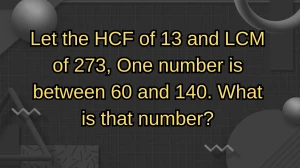Find the Speed of the train, If a train 120m Long passes a Pole in 8 seconds
by
Updated Jun 26, 2024

Find the Speed of the train, If a train 120m Long passes a Pole in 8 seconds
To determine the speed of a train passing a pole in 8 seconds, given that the train is 120 meters long, follow these steps.
The train passes a stationary pole, which means the distance covered is equal to the length of the train itself.
The length of the train is 120 meters.
The train passes the pole in 8 seconds. This is the time it takes for the front of the train to move past the pole completely.
Speed is calculated using the formula
Speed = Distance/Time
Here, the distance is the length of the train, which is 120 meters, and the time is 8 seconds.
Speed = 120/8
Speed = 15 meters per second
Therefore, the speed of the train is 15 meters per second.
How to Calculate Speed?
Speed is a fundamental concept in mathematics and physics that measures how fast an object moves. It is defined as the distance travelled by an object per unit of time. The formula for speed is
Speed = Distance/Time
Where,
Distance is the length of the path travelled by an object.
Time is the duration during which the object travels.
Units of Measurement:
Speed can be measured in different units depending on the context. Common units include meters per second (m/s), kilometers per hour (km/h), miles per hour (mph), and feet per second (ft/s). Choosing the appropriate unit depends on the scale and precision required for the calculation.
Significance:
Calculating speed involves basic arithmetic operations such as division. It also reinforces mathematical skills such as converting units, handling fractions or decimals, and understanding ratios. Learning about speed in mathematics helps one learn to interpret data, solve problems involving motion, and apply mathematical formulas in practical contexts. It builds a foundation for understanding more complex concepts in physics and engineering.
Applications
- Speed is crucial in determining how quickly vehicles or modes of transport can cover distances.
- Speed plays a significant role in athletics and sports. Athletes measure their speed to improve performance and track progress over time.
- Speed is used in physics experiments to study motion, acceleration, and the effects of forces on objects.




